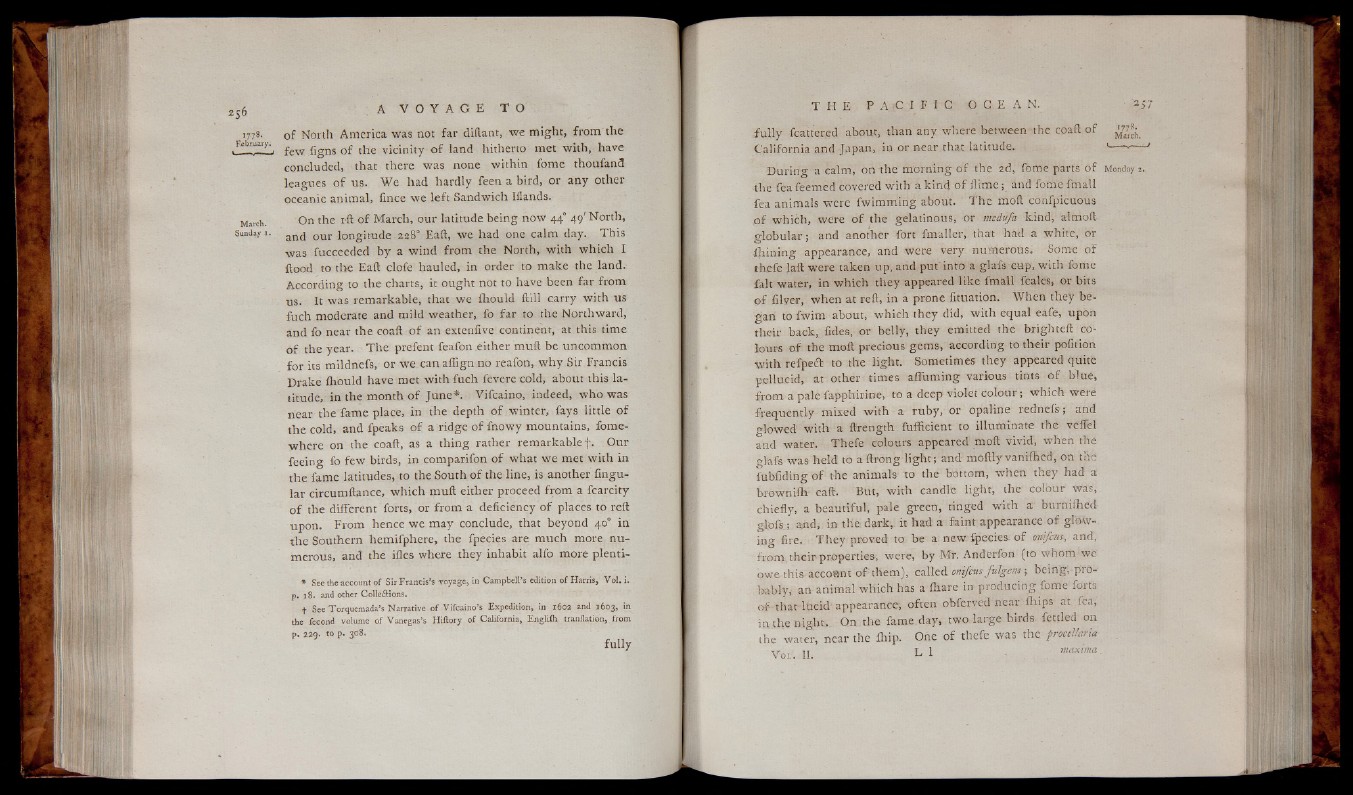
o f North America was not fa r diilant, w e might, from the
few figns o f the vicinity o f land hitherto met with, have
concluded, that there was none within fome thoufand
leagues o f us. We had hardly feen a bird, or any other
oceanic animal, iince we le ft Sandwich Iflands.
On the rft o f March, our latitude being now 44° 49' North,
and our longitude 238° Eaft, we had one calm day. This
was fucceeded by a wind from the North, with w hich I
flood to tire Eaft clofe hauled, in order to make the land.
According to the charts, it ought not to have been far from
us. It was remarkable, that we ftiould ftill carry with us
fuch moderate and mild weather, fo fa r to the Northward,
and fo near the coaft o f an extenfive continent, at this time
o f the year. T h e prefent feafon either muft be uncommon
for its mildnefs, or we can aflign no reafon, w h y Sir Francis
Drake ihould have met with fuch levere cold, about this la titude,
in the month o f June*. Vifcaino, indeed, who was
near the fame place, in the depth o f winter, fays little o f
the cold, and fpeaks o f a ridge o f fnowy mountains, fome-
where on the coaft, as a thing rather remarkable f . Our
feeing fo few birds, in comparifon o f what we met with in
the fame latitudes, to the South o f the line, is another Angular
circumftance, w hich muft either proceed from a fcarcity
o f the different forts, or from a deficiency o f places to reft
upon. From hence we may conclude, that beyond 40° in
the Southern hemifphere, the fpecies are much more numerous,
and the iiles where they inhabit alfo more plenti-
« See the account o f Sir Francis’s Toyage, in Campbell’ s edition o f Harris, V o l. i.
p. 18. and other Colleftions.
f See Torquemada’ s Narrative o f Vifcaino’s Expedition, in 1602 and 1603, in
the fecond volume o f Vanegas’ s Hiftory o f California, Engliih tranilation, from
p. 229. to p. 3x58.
fu lly
M a r ch . fu lly fcattered about, than any where between the coaft o f | g |
California and Japan, iu or near that latitude.
Du rin g a calm, on the morning o f the 2d, fome parts o f M o n d a j
the fea feemed covered with a k ind t>f ilime ; and fome final I
fea animals were fw im m in g about. ï h e moft confpicuous
o f w hich, were o f the gelatinous, or medufa kind, almoft
globula r ; and another fort fmaller, that had a white, or
ih in in g appearance, and were very numerous. Some o f
thefe Jaft were taken up, and put into a glafs cu p , with fome
fait water, in w hich they appeared lik e fmall fcales, or bits ¡¡f filver, when at reft, in a prone fituation. When they be gan
to fwim about, w hich they d id , with equal eafe, upon
their back, fides, or belly, they emitted the brighteft colours
o f the moft precious gems, according to their pofition
w ith refpeft to the ligh t. Sometimes they appeared quite
pellucid, at other times afluming various tints o f blue,
from a pale lapphirine, to a deep violet colour ; which were
frequently mixed w ith a ru by, or opaline rednefs ; and
glowed with a ftrength fufftcient to illuminate the veffel
and water. T he fe colours appeared moft vivid, when the
glafs was held to a ftrong ligh t ; and moftly vaniihed, on tti«
fubfiding o f the animals- to the bottom, when they had a
browniih eaft. But, with candle ligh t, the colour was,
chiefly, a beautiful, pale green, tinged w ith a burniihed
g lp fs j aiid; in the; dark, it had a faint appearance o f glow-,
in g fire. T h e y proved tq be a new fpecies. o f onifcus, and,
from their properties, were, by Mr, Anderfon (to whom w ë
owe this account o f them),- called onifcus fuigem ; being; probably,
an animal which has a fhare in producing fome forts
of- that lucid appearance*, often obferved near ihips at fea,
in the n ight. On the fame day, two large birds fettled on
the water, near the fliip. One o f thefe was the froceUaria